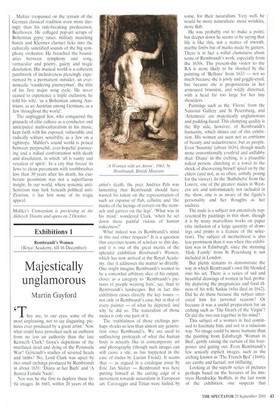Majestically unglamorous
Martin Gaylord
They are, to our eyes, some of the most unpleasing, not to say disgusting, pictures ever produced by a great artist,' Now what could have provoked such an outburst from no less an authority than the late Kenneth Clark? Goya's depictions of the mutilated dead and dying of the Peninsula War? Gericault's studies of severed heads and limbs? No, Lord Clark was upset by two small etchings produced by Rembrandt in about 1631: 'Diana at her Bath' and 'A Seated Female Nude'.
Nor was he the first to deplore these little images. In 1681, within 20 years of the artist's death, the poet Andries PeIs was lamenting that Rembrandt should have wasted his talent on the representation of such an expanse of flab, cellulite and 'the marks of the lacings of corsets on the stomach and garters on the legs'. 'What was in his mind. wondered Clark, 'when he set down these painful visions of human nakedness?'
What indeed was in Rembrandt's mind in this and other respects? It is a question that exercises teams of scholars to this day, and it is one of the great merits of the splendid exhibition Rembrandt's Women, which has now arrived at the Royal Academy, that it addresses the matter so directly. One might imagine Rembrandt's women to be a somewhat arbitrary slice of his output, closer as a category to `Rembrandt's pictures of people wearing hats', say, than to Rembrandt's landscapes. But in fact this exhibition raises directly the key issues — not only in Rembrandt's case, but in that of every painter — of what he depicted, and why he did so. The naturalism of those nudes is only one part of it.
The truthfulness of those etchings perhaps shocks us less than almost any generation since Rembrandt's. We are used to unflinching portrayals of what the human body is actually like in contemporary art and photography (though such images can still cause a stir, as has happened in the case of nudes by Lucian Freud). It seems that — as argued in a catalogue essay by Eric Jan Sluiter — Rembrandt was here putting himself at the cutting edge of a movement towards naturalism in European art. Caravaggio and Titian were hailed, by
some, for their naturalism. Very well, he would be more naturalistic: more wrinkles, more flab.
He was probably out to make a point; but deeper down he seems to be saying that life is like this, not a matter of smooth, marble limbs but of marks made by garters. There is in fact a wilful clumsiness about some of Rembrandt's work, especially from the 1630s. The present-day visitor to the RA is more likely to be shocked by the painting of `Beliana' from 1633 — not so much because she is jowly and goggle-eyed, but because she is preposterous in her armoured brassiere, and wildly distorted, with a head far too large for her tiny shoulders.
Paintings such as the 'Floras' from the National Gallery and St Petersburg, and 'Artemesia' are majestically unglamorous and pudding-faced. This clumping quality is the flip side, however, of Rembrandt's humanity, which shines out of this exhibition. His women are seen not as emblems of beauty and seductiveness, but as people. Even 'Susanna' (about 1636), though much more conventionally youthful and unflabby than 'Diana' in the etching, is a plausible naked person, clutching at a towel in the shock of discovering herself spied on by the elders (and not, as so often, artfully posing for the viewer). In the 'Bathsheba' from the Louvre, one of the greatest nudes in Western art, and unfortunately not included in the show, one is as aware of the figure's personality and her thoughts as her undress.
The nude is a subject not extensively represented by paintings in this show, though it is by many marvellous works on paper (the inclusion of a large quantity of drawings and prints is a feature of the selection). The subject of motherhood is also less prominent than it was when this exhibition was in Edinburgh, since the stunning 'Holy Family' from St Petersburg is not included in London.
But plenty remains to demonstrate the way in which Rembrandt's own life blended into his art. There is a series of sad and beautiful drawings of women in bed, probably depicting the pregnancies and final illness of his wife Saskia (who died in 1642). Did he do these because the subject interested him for personal reasons? Or because it was a useful preparation for an etching such as 'The Death of the Virgin'? Or did the two run together in his mind?
This subject of a woman in bed continued to fascinate him, and not in a salacious way. No image could be more humane than the painting from Edinburgh 'Woman in Bed', gently raising the curtain of the fourposter and gazing out. Even Rembrandt's few sexually explicit images, such as the etching known as The French Bed' (1646), are earthy and factual, not titillating.
Looking at the superb series of pictures perhaps based on the features of his mistress Hendriekje Stoffels, in the last room of the exhibition, one suspects that
Rembrandt's private life and his ostensible subject ran together in his mind. He might be painting a figure from mythology, such as Juno, or a painting to be sold as a tronie, or a generic head of a pretty girl. But the features of Hendrickje, always a little different but recognisable from picture to picture, kept coming through, even after she had died.
In that way Rembrandt is in transition between a painter making a hieratic image of a god or saint and a contemporary painter such as Frank Auerbach, whose works are on show in another part of the RA, who paints the people in his own life. This is a highly rewarding and highly recommended exhibition.







































































 Previous page
Previous page